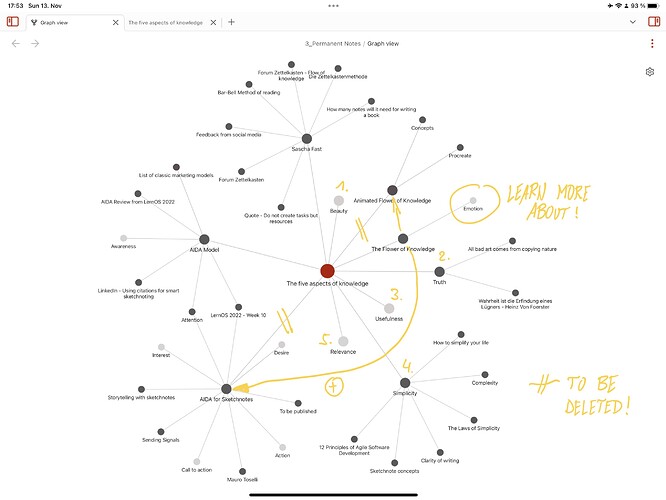I’m curious: I find the graph view neat to look at, but I’m not sure how to use it effectively. What practical benefits do others get? What problems does it help you solve?
My use so far: to see the relative size and therefore “importance” of notes. 10% of the time to discover new notes, but I prefer the random note plugin for that. At first I used to look at the graph a lot, but now I look only when I need an overview of the whole vault
It’s more or less useless right now. A few upcoming enhancements (e.g. center on note and filtering) will help a lot, but it needs considerably more features/power to really be useful (at least once you have a reasonably large database). The more querying and customization power we can get, the better it will be.
One way I use it is in my workflow to easily see unlinked notes. I like how they are on the outside off to themselves. I periodically double check and decide how and where I want these notes to be referenced.
I look at the straggler notes all by themselves. Then i dive into them and make an effort to link them to similar notes. I also tag them too.
I’d like to use it for low-friction, almost exploratory review of my notes – that is, to be able to filter the graph by tags (so I can see all notes on a particular topic), then pick a note on a concept pertaining to the topic that I’m slightly fuzzy on, then “follow” the graph from that concept to connected note-nodes to remind myself of the context, and thereby get quickly myself back up to speed on the topic, especially if I haven’t engaged with the topic recently.
But this will of course require lots of enhancements to the graph view: filters, the option to open notes in new panels, etc.
I am using the graph view for an additional use case.
With a filtered local graph it’s easy to reduce the complexity of the network chart. As already said above we have eight options to filter the graph to focus on a relevant section of our network of ideas:
- search files,
- depth,
- incoming links,
- outgoing links,
- neighbor links,
- tags,
- attachments and
- existing files only.
Here is my 5 steps process to improve my network of ideas:
- Filter the network with a local graph of your note of interest.
- Take a screenshot to fix the filtered result.
- Use your preferred drawing app to do some note-taking on the screenshot.
- Update your network in Obsidian by deleting or adding Links.
- Find new ideas to add in your network like working with a mindmap.
What do you think about this option?
I have found that if every note has at least two links - one of which is a “parent” (meaning it is either a link to an index-type page or a link to something that links to such a page), the graph and local graph features tend to be more useful as navigation than folders are.
I only use the local graph view, because the full graph has become completely useless as the number of notes has grown and there is no way to add types on notes or name and properties on relationship or select what should be displayed or not. So it’s very beautiful to look at, impressive for people you show it to, but for me not exploitable in any useful way. The local view on the other hand is a nice way to show backlinks and color by tags… but unfortunately appart for changing colors it wont try to group them in any smart way so it’s a fancy backlink view. I’m close to just removing the view from my layout for some more useful ones.
